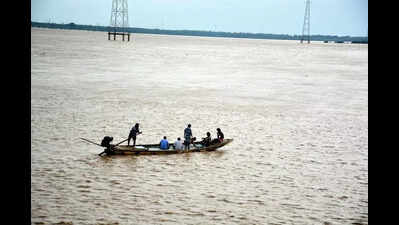Godavari severely polluted with effluents, sewage: IIT-NEERI study

Hyderabad: The lifeline of the two Telugu states, River Godavari, is reeling under severe pollution from industrial effluents, agricultural run-off, and urban sewage, revealed a study.
‘Dakshin Ganga’ — as Godavari is often referred to — encompassing 10% of India’s geographical area, is polluted by industrial effluents in Maharashtra and untreated sewage in Telangana, shows the study conducted jointly by the Indian Institute of Technology- Hyderabad (IIT-H) and the National Environmental Engineering Research Institute (NEERI), Nagpur. It adds that open defecation along its basin in Andhra Pradesh has further deteriorated its water quality, even as its “essence” is lost due to industries, along the river, discharging untreated effluents containing heavy metals and chemicals.
If that’s not all, the river’s natural course spanning 1,460 km — from Nashik in Maharashtra to West Godavari in AP — has been heavily impacted by uncontrolled urbanisation, “resulting in unauthorised construction, deforestation, and encroachments”, the study reveals. Some of these places include: Nashik, Nanded, and Rajahmundry, among others.
These activities, the study highlights, have disrupted the river’s flow patterns and heightened flooding risks. The lower Godavari region, for instance, has been experiencing severe floods almost every alternate year, with major floods occurring once in 10 to 15 years. “During the 2006 floods in Andhra Pradesh, about 460 villages were affected, with nearly two lakh people evacuated and significant damage to crops and infrastructure,” the study reveals.
Given the degradation, the research team has now signed an agreement with the ministry of Jal Shakti under the National River Conservation Plan for a more detailed study. “The preliminary report emphasised all environmental concerns and water contamination issues. The comprehensive study, spanning three years, will focus on research, monitoring, and collecting technical data necessary for evaluating conditions and developing a management strategy for the rejuvenation of the Godavari basin before submitting the final report to the govt,” said a member of the Centre for the Godavari River Basin Management and Studies, CSIR-NEERI, IIT Hyderabad.
‘KILLER’ MINING ACTIVITY
The study pointed out that areas around major dams and reservoirs like the Sriram Sagar Dam, Polavaram Project, and Nagarjuna Sagar Dam have seen large-scale water diversion and infrastructure development, altering natural habitats and river flow. Regions with extensive mining activities, such as parts of Maharashtra and Chhattisgarh, experience land degradation, deforestation, and water pollution due to mining operations.
At Bhadrachalam temple, the water appears black in colour, with a pungent smell in surrounding areas. Here, sand mining was found to be prominently carried out using heavy hydraulic vehicles. Big heaps of sand were found adjacent to the riverbank on both sides of the road, serving as stockyards. The segment also reported issues like solid waste accumulation, water hyacinth, sewage discharge, stagnant water pools in the riverbed, and poor water quality.
MOST POLLUTED STRETCH
An eight-km stretch from Rajamahendravaram to Dowleswaram barrage in AP was found to be among the most polluted stretches along the riverbank in July 2024. Water pollutants, including aquatic weeds, algal bloom, and sewage discharge, were found to have taken a toll on the water quality here. Moreover, surplus untreated wastewater being discharged into the river along with industrial effluent discharge, and narrow channels were noticed.
LOW BOD
The situation in Maharashtra was equally worse where a 300 km upper portion of the Godavari, extending from Nashik district to Paithan, recorded Biochemical Oxygen Demand (BOD) levels between 6 mg/L and 36 mg/L, declared as critically polluted stretches by CPCB. In the Wardha basin in Maharashtra, the river was found to be critically polluted due to coal mining and thermal power plants. Mud from the coal mines and ash from the thermal power plants were found to be routinely disposed of in the river in this region.
















